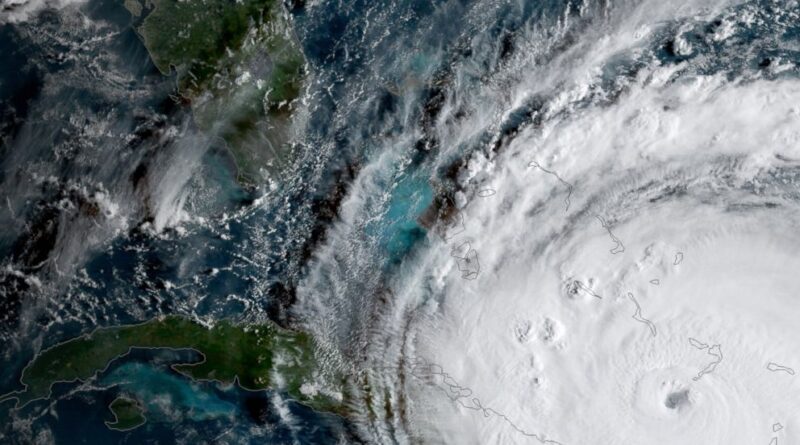Hurricane season is here and meteorologists are losing a vital tool for forecasting them
Meteorologists are losing a sophisticated tool that many say has proved invaluable when monitoring and forecasting hurricanes.
The National Oceanic and Atmospheric Administration (NOAA) announced in a service change notice this week that it would be ending the importing, processing and distribution of data from the Special Sensor Microwave Imager Sounder (SSMIS).
“This service change and termination will be permanent,” wrote NOAA.
The SSMIS instruments are part of three weather satellites in low-Earth orbit and are maintained by NOAA in cooperation with the United States Department of Defense. The SSMIS provides critical weather information that can’t yet be replaced by other satellites and weather instruments, according to NOAA.

NOAA’s GOES-16 satellite captured this image of Hurricane Irma passing the eastern end of Cuba at about 8:00 am on Sept. 8, 2017.
The tool offers forecasters the ability to examine the inner workings of active tropical systems and understand their behavior. Specifically, SSMIS uses microwaves to penetrate clouds and obtain a clearer picture of the inner structure of a tropical cyclone, including its exact center.
Other weather satellites use visible and infrared imagery, which can only capture surface-level details of the cloud tops rather than what’s happening inside the cyclone. These satellites are also ineffective after sunset when it’s too dark to see and when direct observations over open water are scarce. Forecasters, therefore, rely on the data collected from the SSMIS system during these periods.
The SSMIS data not only allows forecasters to better monitor the current progress of a tropical cyclone but also to identify the center of the system for weather forecast models.

Tropical analysis meteorologist Aidan Mahoney looks at monitors as he works at his station at the National Oceanic and Atmospheric Administration’s (NOAA) National Hurricane Center in Miami, May 30, 2025.
Marco Bello/Reuters
Weather forecast models are sensitive to initial weather conditions and rely on multiple sources of accurate weather data for forecasting. Any degradation or discontinuity in the data, whether in terms of quality or quantity, could negatively affect the model’s forecasting skill, scientists warn.
While there is other microwave data available to forecasters, SSMIS accounts for almost half of all microwave instruments, which would dramatically reduce the data available to forecasters. In a worst-case scenario, forecasters say it could lead to missing a tropical system that intensifies overnight, which would not be apparent from using infrared satellite imagery alone.
The SSMIS system is part of the Defense Meteorological Satellite Program (DMSP), which is operated by NOAA on behalf of the Defense Department’s Space Force, which has satellite control authority.
The DMSP program focuses on the design, development, launch, and maintenance of satellites that track weather patterns, oceanic conditions and solar-terrestrial physics.
A Space Force official told ABC News the U.S. Navy is responsible for processing the SSMIS data and providing it to NOAA and they are referring all questions about the decision to the Navy, which did not immediately respond to ABC News’ request for comment.

A screen grab of the NOAA website shows the announcement of the DSMP program being suspended no later than June 30, 2025.
NOAA
In a statement, a Space Force official wrote that “satellites and instruments are still functional.” The official added that Department of Defense users, including the Navy, “will continue to receive and operationally use DMSP data sent to weather satellite direct readout terminals across the DoD.”
Scientists from around the country, meanwhile, expressed their concerns about the decision, stating that it will negatively impact the weather community’s capabilities and accuracy in tracking life-threatening cyclones.

An artist’s rendition of a DMSP satellite orbiting Earth. The Defense Meteorological Satellite Program has been collecting weather data for U.S. military operations for more than five decades and provides assured, secure global weather imagery and space weather data to support Department of Defense operations.
USSF
Matthew Cappucci, an atmospheric scientist and senior meteorologist at @MyRadarWX wrote on X, “Please be aware that this change can and will have a negative impact on the forecasts relied upon by Americans living in hurricane-prone areas.”
Michael Lowry, a hurricane specialist at ABC affiliate WPLG in Miami, wrote on his Substack blog, “The permanent discontinuation of data from the Special Sensor Microwave Imager Sounder (SSMIS) will severely impede and degrade hurricane forecasts for this season and beyond, affecting tens of millions of Americans who live along its hurricane-prone shorelines.”
And Brian McNoldy, a hurricane researcher at the University of Miami, wrote on Bluesky that “For anyone near a hurricane-prone area, this is alarmingly bad news.”
Space Force told ABC News that while the U.S. Navy’s Fleet Numerical Meteorology and Oceanography Center (FNMOC) “is making a change on their end, the posture on sharing DMSP data has not changed,” noting that NOAA has been making DMSP data publicly available, and that many non-Defense Department entities use this data.
